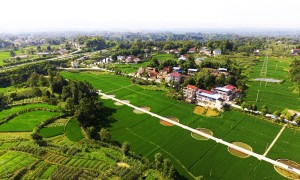丝绸是意大利商人马可波罗穿越数千公里来到中国的主要原因。几个世纪过去了,CCTV记者带您游览丝绸之城杭州。
Silk was the main reason that Italian merchant Marco Polo travelled thousands of kilometers to China. Centuries have passed, and CCTV reporters are following the traveler's footsteps and bring you a view of Hangzhou, known as the City of Silk.
Back when Marco Polo was traveling here silk was the best known export....hence the name the Silk Road. Silk still has a role in Hangzhou today as a key driver in the local economy.
The magic of stitching. Jin Jiahong is keeping the ancient Chinese handicraft of silk embroidery, alive.
She learned how to embroider when she was a teenager, and has been using the same tools for the past thirty five years. She kept up with the practice even when the demand for embroidery work was low.
She said, "I still remember the good old days back in the 1980s when we had to work overtime to finish our clients' orders. The traditional embroidery industry was hit hard when more modern designs became popular.
"We lost our jobs the demand for our talents dropped when machines replaced manual work. I stayed at home for three to four years.
"But I didn’t stop doing embroidery work at that time because I enjoy doing it. But many of my peers, they gave up and changed jobs."
Jin said the hard years gave her the opportunity to switch her role from a manual worker to a designer. Today, most of her work requires at least six months to complete.
To pass on her skills, Jin Jiahong has taken on some new apprentices. She wants to help people find inner peace through handicraft work -- like silk embroidery. She hopes there will always be someone like her who will preserve this traditional skill both in good times and bad.
Instead of exercising in a traditional manner, some are working today as engineers in order to refine and upgrade those time-honored skills and techniques."
Demand for handmade embroidery is on the rise because of the increased popularity of silk around the world. China was the first country to use silk, and it has never stopped promoting this ancient material.
Guess how light this silk is? Believe it or not, its thickness is only 0.052 millimetre. It is the lightest silk in the world.
Xu Dinglong is the engineer who created it.
"The difficult part of making the thinnest silk is getting the right strain of thread. If you use high-speed machines, it is easy to break the thread. It took me six months of work to perfect this," he said.
"I started from the very beginning of the process, from the silkworm, and made changes all the way up to the speed of the machines."
Apart from finding the right thickness, Chinese fabric companies also work tirelessly to perfect their printing and dying methods.
Guo Wendeng and his team worked for two years to create a color transition system that creates near perfect prints.
"Before I created this system, we could only rely on the experience of colorists. It usually took a long time to find a good colorist," he said.
"Over the past two years, we did a number of tests to increase the accuracy of the color on the fabric. We have a similar color system in the printing industry, which is very different than printing on fabric."
With the help of Guo's color transition system, fabric designers can now print their original designs onto silk fabric with much less colour loss.
Chinese craftsmen and engineers are using both traditional skills and modern technology to develop the craft of silk manufacturing. Their hard work helps bring China's culture of silk manufacturing to people around the globe.





![经典常用英语口语500句[收藏]](https://www.yingyuw.cn/file/upload/202110/06/230235911.png)

